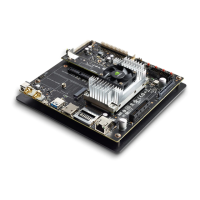NVIDIA Jetson TX2/TX2i OEM Product Design Guide
JETSON TX2/TX2i OEM PRODUCT | DESIGN GUIDE | 20180618 81
5V rail, off in Sleep (SATA/FAN)
VBUS (USB 2.0 Type AB conn)
VBUS (USB 3.0 Type A conn)
5V rail for HDMI connector
1.8V rail for touch screen
High voltage rail for touch
screen
High voltage rail for panel
Generic 1.2V display rail
High voltage rail for cameras
1.2V rail for camera Core
VIN_PWR_BAD# connects to Carrier Board main power input & discharge circuit. Inactive when main supply is stable
CARRIER_PWR_ON used as enable for Carrier Board main 5V supply & discharge circuit
RESET_IN# to/from carrier board connects to devices requiring full system reset, and to system reset sources (reset button, etc.)
RESET_OUT# to the module from Carrier Board when a force reset is required (as for Boundary Scan test mode)
POWER_BTN# connects to button or similar to pull POWER_BTN# to GND when pressed/asserted to power system ON/OFF
SLEEP# connects to button or similar to pull SLEEP# to GND when pressed/asserted to put system in sleep mode
CARRIER_STBY# connects to enable of supplies that should be off in Sleep mode such as VDD_3V3_SLP
VIN_PWR_BAD# connects to Carrier Board main power input & discharge circuit. Inactive when main supply is stable
VDD_5V0_IO_SYS Discharge implemented: FET enabled by DISCHARGE w/Source GNDVDD_5V0_IO_SYS
VDD_3V3_SYS Discharge implemented: FET enabled by DISCHARGE w/Source GNDVDD_3V3_SYS
VDD_1V8 Discharge implemented: FET enabled by DISCHARGE w/Source GNDVDD_1V8
VDD_3V3_SLP Discharge implemented: FET enabled by DISCHARGE w/Source GNDVDD_3V3_SLP
VDD_12V_SLP Discharge implemented: FET enabled by DISCHARGE & VDD_3V3_SLP w/Source GNDVDD_12V_SLP
VDD_5V0_IO_SLP Discharge implemented: FET enabled by DISCHARGE & VDD_3V3_SLP w/Source GNDVDD_5V0_IO_SLP
If Audio Interrupt required, GPIO20_AUD_INT pin is used
If External BT Wake Request to AP required, GPIO13_BT_WAKE_AP pin is used
If External WLAN Wake Request to AP required, GPIO10_WIFI_WAKE_AP pin is used
If Modem to AP Ready required, GPIO17_MDM2AP_READY pin is used
If Modem Coldboot Alert required, GPIO18_MDM_COLDBOOT pin is used
If HDMI CEC required, HDMI_CEC pin is used
If GPIO Exapander 0 Interrupt required, GPIO_EXP0_INT pin is used
If Power Button On required, POWER_BTN# pin is used
If Charging Interrupt required, CHARGING# pin is used
If Sleep Request from Carrier Board required, SLEEP# pin is used
If Ambient/Proximity Interrupt required, GPIO8_ALS_PROX_INT pin is used
If HDMI Hot Plug Detect required, DP1_HPD pin is used
If Battery Low Warning required, BATLOW# pin is used
If Primary Modem Wake Request to AP required, GPIO16_MDM_WAKE_AP pin is used
If Touch Controller Interrupt required, GPIO6_TOUCH_INT pin is used
If Motion Sensor Interrupt required, GPIO9_MOTION_INT pin is used
USB0 available to be used as device for USB recovery at a minimum
USB ID from connector, if used, connects to the module USB0_OTG_ID pin
VBUS from connector connects to load switch (if host supported) and USB0_VBUS_DET pin on the module (100k
required)
USB[2:0]_DP/DN connected to D+/D- pins on USB 2.0 connector/device.
Any EMI/ESD devices used are suitable for USB High-speed
USB_SS0_RX+/– connected to RX+/- pins on USB 3.0 connector, Device, Hub, etc. (muxed w/PCIe #2 on module)
USB_SS0_TX+/– connected to TX+/- pins on USB 3.0 conn., Device, Hub, etc. (muxed w/PCIe #2 on module - See Signal Terminations)
Additional USB 3.0 interfaces taken from USB_SS1 or PEX_RFU (See Signal Terminations)

